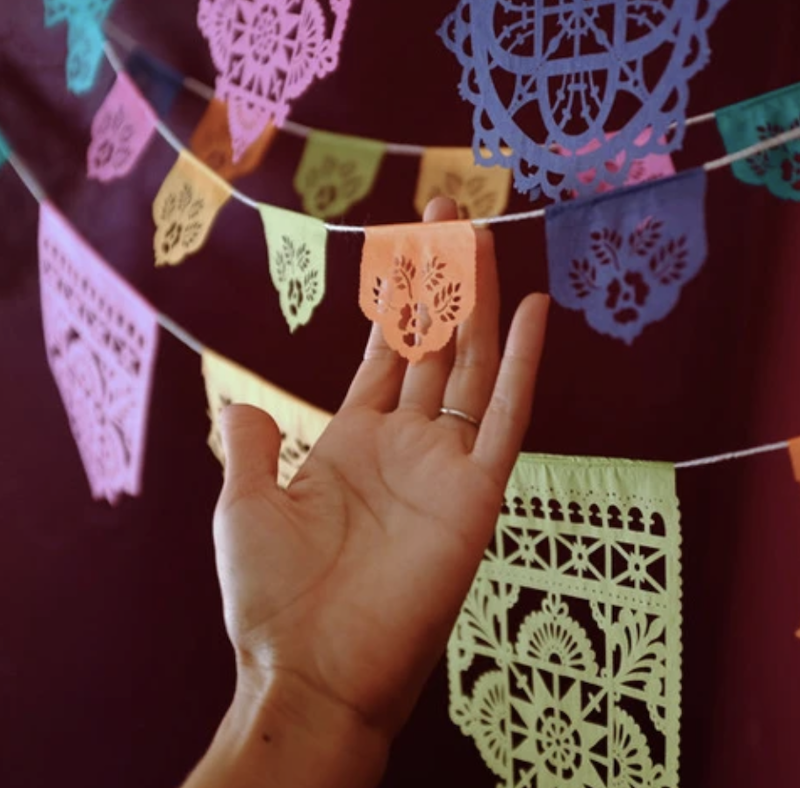Welcome to Facts Vibes! Uncover the intricate beauty of papel picado through our fascinating article. Delve into the history and traditions behind this Mexican folk art, and learn about its cultural significance. Explore the craftsmanship and designs that make papel picado a truly unique and cherished art form.
The Art of Papel Picado: Unveiling Its Intriguing Origins
The Art of Papel Picado: Unveiling Its Intriguing Origins in the context of Mexican Folk Art.
Papel picado, or “perforated paper,” is a traditional Mexican folk art that involves the intricate cutting of paper into elaborate designs. This decorative craft has a rich history with roots that can be traced back to pre-Hispanic Mexico.
The origins of papel picado can be linked to the indigenous people of Mexico, who used paper made from mulberry and fig tree bark for religious purposes. Over time, this art form evolved to incorporate vibrant colors and intricate patterns, particularly in celebrations and festivals.
One of the most notable aspects of papel picado is its connection to Día de los Muertos, or Day of the Dead, where it is used to adorn altars and create a festive atmosphere. Additionally, papel picado is also commonly seen during other traditional Mexican celebrations, such as Independence Day and weddings.
The process of creating papel picado is meticulous and requires great skill. Artists use chisels and special hammers to carve out intricate designs on stacks of tissue paper. The resulting delicate and lace-like patterns are a testament to the artistry and dedication involved in this craft.
Today, papel picado continues to be a beloved art form in Mexico and beyond, with its beauty and cultural significance celebrated worldwide. Its representation of Mexican heritage and traditions makes it a cherished symbol of the country’s rich cultural tapestry.
By delving into the origins of papel picado, we gain a deeper understanding of the cultural significance of this art form and its enduring legacy in the realm of Mexican folk art.
Most popular facts
Papel picado is a traditional Mexican folk art that involves intricate paper cutting.
Papel picado is a traditional Mexican folk art that involves intricate paper cutting.
The art of papel picado can be traced back to pre-Hispanic Mexico, where it was used in religious and cultural celebrations.
The art of papel picado can be traced back to pre-Hispanic Mexico, where it was used in religious and cultural celebrations.
Papel picado is commonly used as decoration for various events and festivities, such as Day of the Dead, Christmas, and Independence Day.
Papel picado is commonly used as decoration for various events and festivities, such as Day of the Dead, Christmas, and Independence Day.
The designs in papel picado often feature motifs such as flowers, birds, and geometric patterns.
Papel picado designs often feature motifs such as flowers, birds, and geometric patterns.
Historically, papel picado was made using hand-cut pieces of tissue paper or mulberry paper.
Papel picado historically was made using hand-cut pieces of tissue paper or mulberry paper.
Today, papel picado is often mass-produced using machinery, but traditional handmade versions are still highly valued.
Papel picado is often mass-produced using machinery, but traditional handmade versions are still highly valued today.
The intricate designs in papel picado are symbolic of the delicate and ephemeral nature of life.
Papel picado designs symbolize the delicate and ephemeral nature of life.
The colors used in papel picado often have symbolic meaning, with white representing the spirit, purple for mourning, and yellow for the sun and unity.
Papel picado colors often have symbolic meaning, with white representing the spirit, purple for mourning, and yellow for the sun and unity.
Papel picado is often displayed outdoors, where it moves gracefully in the wind, adding a dynamic element to the decoration.
Papel picado is often displayed outdoors, where it moves gracefully in the wind, adding a dynamic element to the decoration.
In addition to traditional designs, modern papel picado may feature contemporary motifs and patterns.
In addition to traditional designs, modern papel picado may feature contemporary motifs and patterns.
The art of papel picado has spread beyond Mexico and is now appreciated and used in celebrations around the world.
Papel picado has spread beyond Mexico and is now appreciated and used in celebrations around the world.
Papel picado is sometimes used in religious ceremonies, where it is believed to connect the earthly and spiritual realms.
Papel picado is sometimes used in religious ceremonies, where it is believed to connect the earthly and spiritual realms.
The creation of papel picado requires great skill and patience, as the paper is delicately cut to create intricate patterns.
Papel picado creation requires intricate skill and patience to delicately cut the paper and create intricate patterns.
The tradition of papel picado continues to be passed down through generations, preserving its cultural significance.
The tradition of papel picado continues to be passed down through generations, preserving its cultural significance.
Papel picado has become a symbol of Mexican culture and is celebrated for its beauty and craftsmanship.
Papel picado has become a symbol of Mexican culture and is celebrated for its beauty and craftsmanship.
In conclusion, papel picado is a traditional Mexican art form that holds deep cultural significance. Its intricate designs and vibrant colors are not only visually appealing but also carry historical and symbolic meaning. Through its use in various celebrations and rituals, papel picado continues to be an integral part of Mexican heritage and serves as a beautiful representation of the country’s artistic richness and traditions.
